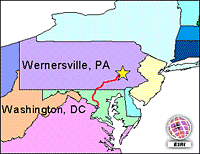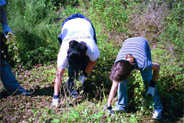Amy Souers is online editor for American Rivers in Washington, D.C. She is on a two-month cross-country road trip exploring America’s rivers.

Monday, 5 Jun 2000
WERNERSVILLE, Penn.
Today I left Washington, D.C., and my home river, the Potomac. Ask any paddler, angler, or other river person in this city and they’ll tell you that the Potomac Gorge, the 15-mile reach from Great Falls to Georgetown, is the wildest, most natural river in a major metro area anywhere in the world.

Slide your boat into the water at the Old Angler’s put-in or hike along the Billy Goat Trail and you’ll see why the river is such a source of local pride: the mountain laurel along the banks, the pot-holed rocks, the great blue herons and the little water snakes, the thundering cascades of the Falls, the delicate casings of dragonfly nymphs above the waterline.
The Gorge is a migratory flyway. If you go out paddling, you’ll regularly see cormorants, and every so often a bald eagle. One hundred rare and endangered plants live along the river. And the Maryland Department of Natural Resources calls the bedrock terrace habitats “more extensive and pristine than anywhere in the Eastern U.S.”
Native Americans have lived on the river since before 4,000 B.C. And as all Marylanders learn in fourth grade, the Potomac was the centerpiece of colonial settlement and the Civil War.
There is a great local group working to protect all of this — the Potomac Conservancy. Since 1993, the Conservancy has been encouraging landowners to donate conservation easements to safeguard the river’s natural features. Members of the Conservancy like to get their hands dirty — from taking water samples to collecting trash to restoring native plants.

Poolesville students pull weeds along the Potomac.
I recently joined the Conservancy and 16 sophomores from Poolesville High School to fix up part of the riverbank that had been damaged in the flood of ’96. Matt Berres, director of watershed programs for the Conservancy, showed us the non-native Japanese stilt grass (Microstegium vimineum) and ground ivy (Glecoma hederacea), and we got to work with the kids, pulling out the plants and filling garbage bags.
Then we grabbed some shovels and planted the grasses and shrubs that belong on the Potomac, the rice-cutgrass, red maple, green ash, spicebush, and shadbush — the ones that provide good habitat and food for insects and birds and wildlife.
“It’s so much better than math class,” said Ameerah, a Poolesville student. “We’re informed. It’s good to do hands-on work.” Her friend Leah, nursing some stinging nettle welts, added, “This is a lot more real than sitting in a classroom.” She wore her welts like a badge of honor. My kind of girl.
This summer, the Conservancy will run evening canoe trips on the river. “We’ve had such great luck teaching kids, why not try it with adults?” asks Carrie Stokes of the Conservancy. “When you’re on this serene, peaceful canoe trip and you suddenly see someone’s backyard totally cleared of trees and mowed right down to the bank, well, it makes you stop and think. Our first goal is awareness. We don’t want to preach at people. We just want to show people this great wild river flowing right through the heart of our nation’s capital.”
The Conservancy is also helping to bring back shad, a migratory fish. Just as salmon are an icon of the Pacific Northwest, shad were once the emblematic fish of the Chesapeake Bay states. Not many people in the D.C. area realize that these fish once threaded their way from the ocean up our rivers and streams, all the way to the Blue Ridge Mountains. While dams and pollution wiped out many shad populations over the past 150 years, today the restoration effort is well underway.
The Conservancy recently helped secure a fish passage at the Little Falls Dam, just downstream from where the Poolesville kids were working. The dam was built in 1959 for Washington, D.C., water supply. The fish passage is a series of three “W” shaped barriers that slow the flow of water through the 24-foot notch in the dam. It’s designed primarily for shad, but other migratory fish like river herring, striped bass, and white perch, and resident species including smallmouth and largemouth bass, bluegill, and walleye, will finally be able to reach critical habitat beyond the dam.
As I drove north from the Potomac today, I crossed another Chesapeake Bay tributary, the Susquehanna. A record number of shad returned here this spring, thanks in large part to better fish-passage facilities at dams and improved water quality.
I stopped in Wernersville, Penn., to have lunch with my grandmother, who we all call Bunny. She has lived in this area for most of her 80 years. She told me about her memories of the Schuylkill River, which flows through Reading, Penn., and empties into the Delaware River. Bunny remembered how she used to visit her great uncle in Reading when she was a little girl. He had a white handlebar mustache and “blue twinkling eyes” and lived in a big white house. He loved to tend his rose beds, but when the Schuylkill overflowed its banks, it would cover his yard and roses in black silt. Bunny explained that this was because the river was full of coal dirt and waste from the many nearby mines.
“When I was little, the Schuylkill was black. And when they finally got around to cleaning it up, well then it actually looked like a river again,” she said.
The river really has come back to life. Over the next several days, the Schuylkill River Greenway Association and 30 other organizations are sponsoring the second annual Schuylkill River Sojourn — a 106-mile canoe and kayak trip for both avid and amateur paddlers.
That’s it for today. As I type this, the clouds are darkening overhead. I hope it pours, so I can go out and play in the rain. I can’t think of a better way to end a long day of driving!
I started out thinking of America as highways and state lines. As I got to know it better, I began to think of it as rivers. Most of what I love about the country is a gift of the rivers. … America is a great story, and there is a river on every page of it.
— Charles Kuralt


